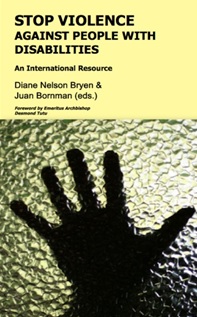Stop Violence Against People with Disabilities!
05-Mar-2014
Guest Post by Diane Nelson Bryen and Juan Bornman
 “The World Health Organization estimates that 10% of the world’s population, which means approximately 450 million adults and 200 million children, experience some form of disability. Individuals with disability are three to four times more likely to experience violence against them than their nondisabled peers. Individuals with disability who cannot speak are particularly vulnerable.” – Archbishop Emeritus Desmond Tutu, in his Forward to Stop Violence Against People with Disabilities! An International Resource, 2014.
“The World Health Organization estimates that 10% of the world’s population, which means approximately 450 million adults and 200 million children, experience some form of disability. Individuals with disability are three to four times more likely to experience violence against them than their nondisabled peers. Individuals with disability who cannot speak are particularly vulnerable.” – Archbishop Emeritus Desmond Tutu, in his Forward to Stop Violence Against People with Disabilities! An International Resource, 2014.
These shocking statistics show how critical it is to focus attention on the violence endured by many people with disabilities around the globe. The new e-book Stop Violence Against People with Disabilities! An International Resource reaches beyond simply describing the problem. Contributors relate experiences of people with disabilities who have been victims of violence, and explore practices that offer hope.
Listen to the voices of a few of the people who shared their stories:
I believe that every child looks up to an adult for safety, protection and guidance and for loving warmth. Not for an adult to take advantage of the love that the child is giving back to them as thanks for looking after me. … I never thought that I would to have to live my childhood in fear of getting hurt by a family friend. In my early years, I was a cute, bubbly, fun kid with no worries…. I thought that every adult I met was my guardian, someone I could ask for help when in need. I remember the day the guy called Lucas changed my life. – Young woman from South Africa
She went to a public school and completed grade 12. However, she was never taught to read nor did she receive an AAC device. Due to her cerebral palsy she had little functional speech – in her case, her speech was unintelligible to most unfamiliar people. Her rapist assumed that if she tried to tell someone, they would not believe her. And if a family member did believe her, she would not be believed when she tried to tell the police or testify in court, because she could not be understood due to her unintelligible speech. She had no other way to communicate effectively. – Young woman from the US
The teachers noticed that Ramesh was wetting his pants…. Young men with disability were questioned, and using a communication board they reported that the caregiver was touching them inappropriately. The matter was reported to the police, but after a few queries the violator was let off. He was let off because the police did not believe that a person with disability, who could not speak, could actually communicate the subtle difference between being touched for toileting and being touched inappropriately. – Young man from India
One Saturday afternoon I was waiting at home for my friend who has no speech to come over and finalize a presentation. She was a little late, so I texted her and asked if she had been caught up in public transport. She texted back, “No I have been assaulted.” Immediately a thousand things started running through my head. Has her communication device been stolen? Will she be able to communicate her story to police? Will she be believed? … This event made the topic of this chapter even more real to me. Suddenly, I was not just talking about people who I hadn’t met nor random statistics, I was talking about a problem that was very real. – Fiona Given, Chapter author, attorney, and woman who uses AAC from Australia
India Ochs, one of the Chapter authors, is a lawyer and a woman who uses AAC. She cautions that it is not easy for a person with complex communication needs to simply fight back. “Very often, people do not fight back simply out of fear,” says India. “While this kind of fear may be based on an attempt to avoid additional physical harm, fear can also come from an internal belief that the person does not have a right to fight back. Such beliefs are wrong.”
To order your digital copy of Stop Violence Against People with Disabilities! An International Resource, click on this link to Kindle eBooks. Once there, you can “Look inside” to read a sample of the book and order it for only US$3.99. This Kindle eBook can be read on Kindle readers, iPhone, iPod, or iPad, on any computer, and through the Cloud Reader. It is also voice enhanced.
Diane Nelson Bryen, PhD is Professor Emerita from Temple University, USA, and Extraordinary Professor, University of Pretoria, South Africa, and Juan Bornman, PhD is Director of the Centre for AAC at the University of Pretoria, South Africa. Diane and Juan are editors of Stop Violence Against People with Disabilities! An International Resource (2014). Many of the authors who contributed to the book are members of ISAAC.